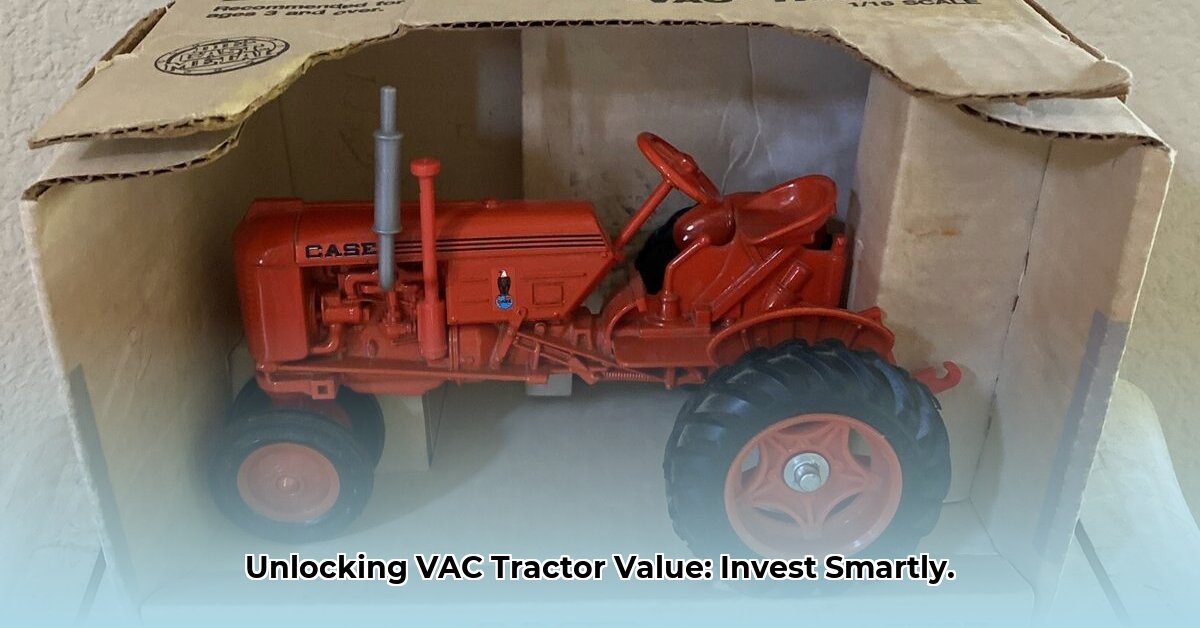
Factors Influencing Case VAC Tractor Value
The value of a Case VAC tractor is a complex equation, with several key variables determining its worth. Understanding these factors is crucial for both buyers and sellers navigating this specialized market. For more information on Case tractors, check out this helpful resource: Case Tractor Info.
Condition: The Cornerstone of Value
The condition of a Case VAC tractor significantly impacts its value. A meticulously restored tractor, gleaming and ready for display, commands a significantly higher price than one showing signs of extensive field use. Think of it like classic cars – pristine examples are premium. Even a well-maintained, functional tractor will hold value, but top dollar is reserved for mint condition.
Model Specificity: Rarity and Desirability
Specific Case VAC models hold varying levels of collector appeal. Certain models are rarer than others, leading to increased demand and higher prices. This rarity factor is a significant driver in the overall valuation process. Thorough model identification is essential for accurate valuation.
Geographic Location: Local Market Dynamics
The geographic location of the tractor also plays a role in determining its value. Regions with strong collector communities or agricultural history museums often see increased demand, resulting in higher prices. Local market dynamics can significantly impact the final sale price.
Economic Climate: The Broad Macroeconomic Context
The overall economic climate influences the collector market. During periods of economic prosperity, disposable income rises, increasing demand for luxury items like vintage tractors. Conversely, economic downturns can soften prices. This macroeconomic factor presents both opportunities and risks.
How to Determine the Fair Market Value of Your Case VAC
Accurately assessing the value of your Case VAC requires a methodical approach. Following these steps will help ensure a fair market valuation:
Precise Identification: Begin by meticulously identifying the precise model number and year of manufacture. This crucial step forms the basis of your valuation.
Comprehensive Documentation: Create detailed documentation, including high-resolution photos and a detailed description of the tractor's condition. Note any repairs, modifications, or original parts.
Comparative Market Analysis: Research online marketplaces (eBay, specialized agricultural auction sites) and review recent sales of comparable Case VAC tractors. Pay close attention to condition, features, and final sale prices.
Regional Market Context: Consider the local market conditions and the strength of the collector base in your area. Adapt your pricing to reflect regional demand.
Professional Appraisal (Recommended): For high-value tractors, a professional appraisal from a qualified expert provides an impartial assessment, offering strong validation for your pricing strategy.
Navigating the Case VAC Tractor Market: Trends, Strategies, and Risks
The Case VAC tractor market is dynamic, with prices fluctuating based on various factors. Understanding these fluctuations is key to successful navigation of the market.
Market Trends and Investment Strategies
The market exhibits a general upward trend, but there are significant variations between models and conditions. Specific models experience more pronounced price swings than others.
Investment Strategies:
Diversification: Spread your investments across multiple models and conditions to mitigate risk and capitalize on varied market performances.
Long-Term Perspective: Consider vintage tractor collecting a long-term investment, requiring patience and knowledge for optimal appreciation.
Mitigating Investment Risks
Investing in vintage tractors involves inherent risks. Proactive mitigation strategies are essential for protecting your investment.
| Risk Category | Mitigation Strategy |
|---|---|
| Market Fluctuations | Diversify your holdings; adopt a long-term investment horizon. |
| High Restoration Costs | Assess restoration needs thoroughly; leverage your skills or find qualified professionals to reduce labor costs. |
| Part Scarcity | Build relationships with reputable parts suppliers; proactively acquire spare parts. |
| Questionable Authenticity | Verify authenticity through diligent research and professional appraisal. |
| Storage and Maintenance | Provide suitable storage; establish and maintain a regular maintenance schedule. |
Predicting Future Value: A Multifaceted Approach
Predicting future value requires a comprehensive understanding of market dynamics and a detailed analysis of the specific tractor.
Market Dynamics Analysis
The value of a vintage Case tractor, like any collectible, is driven by supply and demand. Thorough research into model desirability, historical significance, and mechanical capabilities is vital.
Condition remains a paramount factor. A fully restored tractor commands a significantly higher price than an unrestored example. Restoration costs must be carefully factored against projected future value increase.
Location also affects value. A highly-sought-after model in a strong collector's market will likely sell for a premium.
Case VAC Specific Trends Analysis
While comprehensive data is limited, utilizing online forums, auction results, and insights from vintage tractor enthusiasts can supplement available data. Remember that market trends are fluid and influenced by economic conditions and evolving collector preferences.
Practical Prediction Steps
Model-Specific Research: Precise model and year identification is crucial for determining rarity and collector appeal.
Detailed Condition Assessment: Conduct a thorough mechanical inspection, documenting the tractor's condition with photos and descriptions.
Comparative Sales Analysis: Research comparable sales data to establish a realistic baseline value.
Contextualization: Consider the local market and adjust pricing based on regional demand.
Restoration Costs: If restoration is planned, thoroughly estimate the costs.
Ongoing Monitoring: Consistently review market trends to adapt your strategies.
Risk Mitigation and Investment Strategies
Diversification and a long-term strategy are key to minimizing risk and maximizing returns in the vintage tractor market. Thorough pre-purchase inspections, building a network of parts suppliers, and verifying authenticity all contribute to a wiser investment decision.